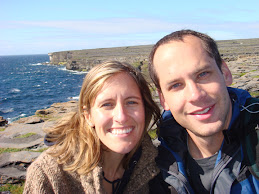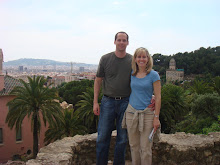But we decided to give it our best shot (pardon the pun).
Every time we turned our heads, another gorgeous lake, mountain, valley, forest, Alpine-style building or cow appeared as if to taunt us. I’m not sure we really ever put down our cameras the entire trip…except to eat or sleep.
Photographically speaking, Damon met his match in Switzerland...or at least his camera did. In just four days, he burned through 10 MB of memory and two batteries. On our last night in the country, my memory chip declared itself full right before my last battery died.
One of the greatest parts of traveling in Switzerland is its compact size. It’s bordered by five countries: Germany, France, Italy, Austria and Liechtenstein. This makes travel (by train or car) quite easy, but it also gives Switzerland its fascinating cultural diversity. There is really no Swiss language; cultural traditions, lifestyle and language are influenced by the borders. While German is the most prevalent language, 20 percent of the population near the France border count French as their official language. Close to that many do the same on the Italian border.

One of the bummers about Switzerland is cost of living. Switzerland is very expensive for everyone – food, drink, hotel, train tickets, gondolas, you name it. The only thing we found that was not more expensive than Ireland was gasoline, surprisingly. But in all honestly, with restaurants perched on river banks and cliffs with great food and service, you can’t blame them for charging what they do. The views alone are worth the price.
We flew Ryanair from Dublin to Basel direct. It was the first time we’d ever been to an airport where the exit signs directed us to two different countries: Switzerland or France. Then we drove north to the German border, which took all of maybe 15 minutes. We walked around the town of Freiburg in the southwest corner of Germany, and visited its cathedral and ate an authentic Bratwurst before driving through the Black Forest. The winding roads and forested hills reminded us of our commute back home.
Germany Photos:
We crossed over into Switzerland and stopped at Rheinfall, the largest plain waterfalls in Europe. We ate dinner on the terrace of a riverfront restaurant in Stein am Rhein, a town famous for its Hans Christian Andersen-style architecture. The restaurant specializes in fish from the river, so we had perch and bass. We watched kids jump off the bridge into the chilly waters below while we ate. Little did we know that a Swiss game show with card players was broadcasting live from the center of Stein am Rhein. We watched the game show host parading around the streets, as residents sat at dozens of picnic tables drinking beer. As part of a competition, a young couple sawed a log. It was truly a step back in time. On the first night, we stayed at the cute Seegaertli B&B in Berlingen, a town on the shores of Untersee, part of Lake Konstanz. Our room had a balcony and views of the lake. The owners had a private beach and patio area across the road for guests to enjoy, but we didn’t have time to enjoy it.
Lake Konstanz was our first destination the next morning. The northeast border of Germany and Switzerland rests just outside the center of Konstanz, the village. We strolled through the village’s old town, saw its cathedral, then walked across the big bridge over the lake before starting our drive to Interlaken.
Rheinfall, Steim am Rhein, Berlingen and Konstanz Photos:
We drove through Zurich, Switzerland's largest city, and the beautiful regions south of Zurich with many lakes (Lucerne, Zugger, Alpnacher, Sarner, Lungerer).
Interlaken is an alpine village near the center of the country, within the region known as Bernese Oberland. Interlaken is flanked by two lakes, and is a great base for the best peaks in the Swiss Alps. Damon had been talking about taking the Jungfraujoch train to the highest train station in Europe to see Jungfrau since last fall. He wanted to photograph the Alps from over 11,000 feet. We arrived into town mid-afternoon under blue skies. It was too late to go to Jungfrau, so the owner of Rugenpark B&B where we stayed recommended Schilthorn. He said the views of all the highest peaks (Jungfrau, Mönch, Eiger) were actually better from Schilthorn. We could even see Thun and Lake Thun.
We rode three separate gondolas to reach Schilthorn. All I can say is, “Holy Schilt.” Schilthorn is a mountain located at about 10,000 feet. The views were breathtaking. We hiked out to a ridge and took some funny photos with a caution sign featuring a high-heeled shoe (???). On the way down from Schilthorn, we got off the gondola at Murren, a pedestrian-only traffic city (supposedly, but we found a couple transport vehicles). Murren was really charming. The mountain views were gorgeous, the architecture cute. We ate fondue and Swiss beer outside on the terrace of a restaurant overlooking a steep valley.
The weather didn’t cooperate the next day. This happens in Switzerland, we’re told. We couldn’t go to Jungfrau--who would want to pay $200 per person to take a train up the mountain to only see a wall of fog--so we ventured out into the rain to go see Trummelbach Falls. This amazing waterfall is a series of 10 glacier-fed waterfalls flowing through one cave, the only one of its kind in Europe open to the public, we were told. The snow-pack run-off from Eiger, Monk and Jungfrau shoots down through this cave. Watching the insane water pressure was quite an experience.(Trummelbach is a UNESCO Heritage Site.)
Next we drove to Grindelwald village and did some shopping in the rain, then ate sandwiches in the park. Once it stopped raining, we took a bus to the stop just below Upper Glacier. (Our bus drive said “hello” in German, “thank you” in French and “good bye” in Italian. If that doesn’t sum up Switzerland’s diversity, I don’t know what does.)
We hiked into the entrance of Upper Glacier, then climbed up all 887 log steps (Damon counted) to the rocky, flat tops of the cliff to see the glacier. The glacier wasn’t really visible (it’s been receeding for a few decades, sadly), but the climb up and the walk across the suspended bridge made the trip worthwhile. I snapped a photo of the traditional Swiss drummers (gigantic cowbells for drums!) in the town of Lauterbrunnen. We celebrated (or negated) our climb with a banana split at the restaurant located near the base of the mountain. That evening, we took a walking tour of Interlaken (in the rain), bought some Swiss chocolates from the famous Schuh shop and restaurant, then grabbed a casual dinner at Brasserie 17 in the bar-cum-restaurant-cum hostel.
Time to move along. We packed up our things the next morning and drove to Thun, a town on the Thunersee (Lake Thun) west of Interlaken. We toured Thun castle, then walked through town and over its bridges before continuing on through the Berne canton, the more scenic drive to Lake Geneva. We stumbled upon a beautiful waterfall along the way, which flows into the Jaunbach stream, and stopped at Jaun to photograph it. We also took pictures of the cows and the gigantic bells around their necks. (Chiming cow bells were within ear shot at two out of three places we stayed.) Check out this video we filmed with my cell phone:
Interlaken, Thun (Bernese Oberland) Photos:
The road signs soon changed from German to French. We stopped in the town of Gruyeres in the Fribourg canton, famous for its cheese, and visited the cheese center (more of a tourist trap than anything). But the cheese aging room was cool to look at, and we were able to say we tasted Gruyeres in Gruyer...what more could you ask for?
We arrived in Corseaux, one of the many villages on the border of Lake Geneva, in the late afternoon. (Lake Geneva is shared with France, where it's known as Lake Leman.) Our B&B (and its pool) overlooked the lake and mountains. We toured Chateau de Chillon just outside of Montreux, then walked along the Montreux boardwalk and ate a nice Italian dinner at Restaurant au Parc. The next morning, we took a train up to Les Pleiades, an area in the mountains overlooking Lake Geneva, but it was too rainy and foggy to see anything. We then drove through the Lavaux wine region and photographed its stony terraces, built by monks 800 years ago. These vineyards and their terraces are a UNESCO Heritage Site. The views of the steep vineyards, lake and mountains were absolutely stunning. If I hadn’t fallen in love with Switzerland yet, I did right then. We stopped at a few wine villages before driving over to Lausanne, located across the lake from France's Evian (yes, that Evian). Lausanne’s cathedral sits at the top of a hill. We climbed to the top, toured the church, then climbed up into its tower. The tower bells rang while we were still at the top…very cool. We decided to buy some wine and local products (ham, cheeses, nuts, chocolates) and return to Lavaux for a picnic. The sun finally broke from the clouds while we ate at a arbor-covered picnic area next to the vineyards. That night we listened to jazz at the world-famous Montreux Jazz Festival, held there since 1967, and took another stroll down the Montreux promenade. We witnessed the most gorgeous sunset, but we’d both already ran out of memory on our cameras.
Montreux, Lavaux and Lausanne Photos:














No comments:
Post a Comment